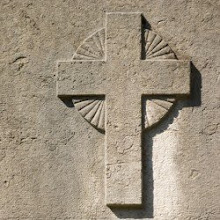Thomas Aquinas, when he was not yet 50 years old, died on his way to the Council of Lyon. When he received the Lord's Supper for the last time, he said, "I receive you, ransom price of my soul. For love of you I have studied and worn myself out. You I have preached and taught...." Thus the greatest thinker of the Middle Ages took leave of the uncompleted work to which he had given his life. Forgotten is all the wealth of his philosophical and theological knowledge. His system, which takes in heaven and earth, world and super-world, has now shrunk to the "one thing needful." Now, like Paul, he knows only "Jesus Christ and Him crucified" (1 Cor. 2:2), whose body and blood he receives for the last time on this earth, the price paid to redeem his soul. This Christ is the content of all theology. Forgotten is the theology of glory of the half-heathen proofs for the existence of God at the beginning of the Summa theologiae. Forgotten is the belief in the abilities of the natural man. Forgotten is the "triumph of theology" which Thomas celebrated in overthrowing Averroism, which had become a subject of art.At the same time, Sasse doesn’t hesitate to point out, and agree with, the historical Lutheran view that the office of the pope is the Antichrist (though not the only Antichrist):
We dare never forget this genuinely Christian, evangelical side of the Middle Ages if we would rightly understand the Reformation. The original evangelical elements that are preserved in the Mass, with its "You alone are the Holy One" in the Gloria, the "Not weighing our merits, but pardoning our offences" in the Canon of the Mass, the Kyrie and the Agnus Dei, the Words of Institution and the formula of Baptism, the "King of majesty tremendous, who dost free salvation send us" in the Mass for the dead, the constant pointing to the thief on the cross-all this, as Luther recognized, sustained the life of the church in the Middle Ages, and sustains it still in Catholicism today. We should never forget that "by grace alone" (sola gratia) is a possibility also in Roman Catholicism, though only one possibility among others, and only in such a way that it can never become "by faith alone" (sola fide). Whatever else the Roman Church may be, it wants to be-and is-church of the cross, church of the Crucified One. His sacrificial death means more in its life and thought than in the life and thought of many a Protestant church. Only God knows whether in our day there are not many more Catholics who die with faith in the saving merit of Christ than Protestants. (44)
That there may be no doubt about our position, let it be clearly said: A theologian who merely because it happens to be in the Confessions lets the doctrine stand that the pope is the Antichrist, and is not solidly convinced that it is so, cannot truthfully be called a Lutheran. (118)He continues:
If there was any doubt on the part of some Lutherans as to the correctness of Luther’s judgment, then this was removed when Pius IX, with the consent of the Vatican Council, on 18 July 1870 promulgated the constitution Pastor aeternus. In it eternal salvation was denied to those who consciously oppose the dogma that the pope has the exercise of direct episcopal power over the whole church, over the infallibility with which Christ has equipped His church, and that his ex cathedra decisions in questions of faith and morals are, “of themselves, and not from the consensus of the church,” true and irreformable (ex sese, non autem ex consensus Ecclesiae irreformabiles [Denzinger 3074]). And when the first of these new ex cathedra decisions was proclaimed—the dogma of the Assumption of Mary, in 1950, on All Saints’ Day, the day inseparably connected with the Reformation—the shock wave hit all Christendom. Here became visible something of the reality which Luther had recognized with deep dread—the reality of the man who puts himself in God’s place and proclaims his fantasies as divine revelation. (120)Sasse further mentions:
It was Luther’s deep understanding of the Gospel that enabled him on the one hand to recognize its fearful perversion in the papacy, and on the other hand to give a positive evaluation of those elements of the true church of Christ that still live on in the Roman Church. The same Smalcald Articles which so sharply delineate the doctrine of the Antichrist also acknowledge that “the sublime articles of the divine majesty” “are not matters of dispute or contention,” and give a considerable list of those matters which they wish to discuss with the Roman theologians. (124)The Council of Trent, which established Roman Catholic doctrine and which remains their official position, states in Canon XII: “If any one saith, that justifying faith is nothing else but confidence in the divine mercy which remits sins for Christ's sake; or, that this confidence alone is that whereby we are justified; let him be anathema.” This is a clear repudiation of justification by grace through faith, and thus a clear rejection of the Gospel. Thus, while we can be thankful that there are Christians to be found within the ranks of the Roman Catholic Church, we must also point out their church’s false doctrine and be willing to gently instruct those we might have opportunity to speak with and lead them to the truth.
Hermann Sasse, We Confess Anthology, Trans. Norman Nagel (St. Louis: CPH, 1999)
photo credit: Catholic Church (England and Wales)







No comments:
Post a Comment